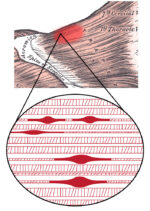We often hear people saying they have ‘knot’ in their muscles.
Does that mean their muscle fibres actually tie themselves into a knot? Thankfully, no.
So what is a muscle knot? The medical term for a knot is a myofascial trigger point, which refers to a part of the muscle that has tensed up. To touch, they can feel like a taught band with a lump, hence the word ‘knot’ is used to describe them.
There are two types of trigger points; active or latent. Latent trigger points are only sore when pressure is applied and are generally harmless. Active ones on the other hand can create an intense pain that can be sore without pressure. This pain can also refer to other parts of the body.

So what causes a muscle knot? There are many causes of myofascial trigger points. Here are a few more common ones:
- Repetitive use (and especially overuse) of a muscle
- Lack of strength
- Poor posture
- Trauma/injury
- Lifestyle factors such as diet, exercise, smoking/drinking alcohol and stress
How can I fix knots and what can you do to prevent them?
- Strengthening: This will help make muscles more resilient to strain, strengthen postural muscles and help correct any muscle imbalances which can lead to trigger points. Make sure your exercise regimes also include warm ups and cool downs to protect muscles and prevent trigger points.
- Stretching: Be gentle with stretching and don’t push into pain. Try to hold for at least 30-60 seconds and do regularly for prevention.
- Hot and Cold Therapy: Heat can help soothe muscle pain and cold therapy can help with reducing inflammation. You can either alternate between the two or see which one feels better for you.
- Lifestyle factors: These can influence muscle and overall health; therefore, it is important to address factors such as stress, sleep, hydration and diet. Your health professional can guidance through any necessary changes if needed.
- Physiotherapy: Physiotherapy is the main form of muscle knot treatment. Your physiotherapist can guide you through specific exercises to strengthen and stretch the right muscles to prevent recurrence, as well as perform manual therapy techniques such as trigger point releasing and dry needling to facilitate your recovery. Hands-on manual therapy is quite important in dealing with muscle knots.
Komal Cleland, Musculoskeletal Physiotherapist, Growing Younger Physiotherapy Howick
To make an appointment for a physiotherapy consultation in our Howick clinic contact us here
